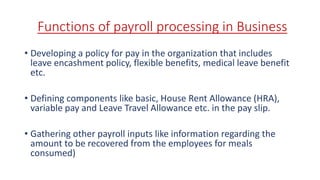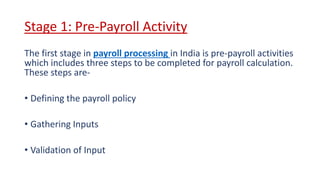Outsource your payroll processing with ezybiz india consulting llp
- 1. Presented By: Anil Agrawal
- 2. Table of Content 1. What is payroll processing? 2. Steps involved in payroll processing 3. Functions of payroll processing in Business 4. Stages of payroll (a) Stage 1: Pre-payroll Activity (b) Stage 2: Actual Payroll Process (c) Stage 3: Post-payroll Process
- 3. 5. Types of allowances under Payroll Processing (a) House Rent allowances (HRA) (b)Transport Allowance (TA) (c) Medical Allowances (d) Meal Coupons/Education Allowances (f) Leave Travel Allowances (g) Other allowances 6. Methods of Payroll Processing (a) Excel based Payroll Management (b) Using Payroll Software (c) Payroll Outsourcing Table of Content
- 4. What is Payroll Processing? ŌĆó A task of managing salary or wages payments of the employees by the company. ŌĆó Most companies use payroll software system to calculate payrolls ŌĆó Or they use third party payroll processing outsourcing services.
- 5. Steps involved in Payroll Processing The steps involved while processing the payroll are- 1. Gathering the employee time information for a particularly selected time period. 2. Managing all the given benefits and the made deductions. 3. Distribution of the payment for the calculated time period.
- 6. Steps involved in Payroll Processing
- 7. Functions of payroll processing in Business ŌĆó Developing a policy for pay in the organization that includes leave encashment policy, flexible benefits, medical leave benefit etc. ŌĆó Defining components like basic, House Rent Allowance (HRA), variable pay and Leave Travel Allowance etc. in the pay slip. ŌĆó Gathering other payroll inputs like information regarding the amount to be recovered from the employees for meals consumed)
- 8. ŌĆó Actual calculation of the gross salary, statutory and non- statutory deductions, and arriving at the net pay of the employee. ŌĆó Releasing the salary of employees. ŌĆó Depositing dues like Provident Funds, TDS, TA/DA etc. with appropriate concerned authorities and filing the returns timely. Functions of payroll processing in Business
- 9. Stages of Payroll There are three stages under the payroll processing services. These are- 1.Pre-payroll activities 2.Actual payroll process 3.Post payroll activities
- 10. Stage 1: Pre-Payroll Activity The first stage in payroll processing in India is pre-payroll activities which includes three steps to be completed for payroll calculation. These steps are- ŌĆó Defining the payroll policy ŌĆó Gathering Inputs ŌĆó Validation of Input
- 11. Defining payroll policy ŌĆó Multiple factors affects net amount salary of employees. ŌĆó Consider the well defined policies of the company such as pay policy, leave and benefits, etc. ŌĆó Policies must be approved by the management of the company to ensure standard payroll processing is being followed.
- 12. Gathering inputs ŌĆó It involves interaction within multiple departments and officials. ŌĆó Information and data related to salary revision during mid-year, attendance, leaves etc. to be collected. ŌĆó The task of gathering information can be hectic/overwhelming. ŌĆó CompanyŌĆÖs must use smart payroll software having integrated features such as leave and attendance management, employee self-service portal, etc.
- 13. Input validation ŌĆó Inputs are collected or received. ŌĆó Validity of the data concerning compliance and adherence to company policy, authorization, right formats, etc. needs to be ensured and checked. ŌĆó Ensure that none of the active employee is missed out as well as no inactive employee records has been included during salary payment.
- 14. Stage 2: Actual Payroll Process Payroll calculation ŌĆó Input data that has been validated is fed into the payroll system for the actual payroll processing and calculation. ŌĆó The result after adjusting necessary taxes and other deductions is the net pay of the employees. ŌĆó Reconciliate the values and numbers and verify it for accuracy to avoid any errors and mistakes.
- 15. Stage 3: Post Payroll Process The four steps involved in the last and final stage of Post Payroll Process are- ŌĆó Statutory Compliance ŌĆó Payroll Accounting ŌĆó Payout ŌĆó Reporting
- 16. Statutory compliance ŌĆó At the time of payroll processing, all statutory deductions like EPF, TDS, ESI are made. ŌĆó The amount is to be remitted to the respective agencies of the government. ŌĆó The frequency of the remittance varies depending on the type of the dues or transactions and such dues are made through challans.
- 17. ŌĆó Once the dues are paid, returns and reports are to be filed such as for PF return filing, ECR has to be generated and filed. Statutory compliance
- 18. Payroll accounting ŌĆó Organization keeps a record of all its financial statements and transactions. ŌĆó Salary payments is one of the most significant costs which has to be entered in the books of accounts. ŌĆó It is essential to check that all salary and reimbursement transaction data is accurately fed and entered into accounting system.
- 19. Payout ŌĆó Companies can pay salary by cash, cheque or even bank transfer. ŌĆó Companies provide employees with a bank account for salary. ŌĆó CompanyŌĆÖs bank account must have sufficient funds to make the payments. ŌĆó A bank advice salary statement is to be sent to the concerned
- 20. ŌĆó Branch or department along with particulars and details like employee id, bank account number, amount of wages/ salary, etc. ŌĆó If the company has opted for a payroll software that already has self-service portal for employees, pay slip can easily be published for the employees whenever they log-in to their account and access it. Payout
- 21. Reporting ŌĆó After completion of payroll for a particular month, finance department and higher management may ask for reports containing the data related to department wise employee cost, location wise employee cost, etc. ŌĆó The responsibility of the payroll officer is to dig into the data to evaluate and extract necessary information and share the reports with the authorities.
- 22. Types of allowances under Payroll Processing Allowances provided in India include the following: ŌĆó House Rent allowances (HRA) ŌĆó Transport Allowance (TA) ŌĆó Medical ŌĆó Meals ŌĆó Leave travel ŌĆó Education ŌĆó Special allowance
- 23. House Rent Allowances (HRA) House Rent Allowance (HRA) allowance exempted from taxes has to be the lowest of the three following options: 1. 50 percent of the full salary in metropolitan cities or areas (40 percent in non-metropolitan cities or areas) 2. Total paid rent which can be 10 percent of the total salary. 3. Received HRA by the employee.
- 24. Travel Allowances (TA) ŌĆó Transport allowances of up to Rs. 800 per month for an employee travelling between their residence and work place are exempted from taxes. ŌĆó In the case of physically handicapped employees, Rs. 1,600 per month is exempted from taxes.
- 25. Medical Allowances For medical expenses below mentioned exemptions are allowed: ŌĆó Reimbursement of up to Rs. 15,000 for medical treatment of the employee and their family members. ŌĆó Reimbursement of expenses incurred by an employee and family members in an approved hospital. ŌĆó Payment of premium by the employer towards medical insurance for the health care of the employees.
- 26. ŌĆó Reimbursement of the premiums paid by the employee towards medical insurance for his/her health or of that of their family. ŌĆó Any expenses incurred by the employer on medical treatment of the employee whose family is outside of India. ŌĆó Travel and housing expenses abroad for the employee or their family including the expenses of one attendant accompanying the patient for the purpose of medical treatment. Medical Allowances
- 27. Meal Coupons ŌĆó Lunch and refreshments provided to the employees by the employer for free or concessional rates are non-taxable. Education ŌĆó Education payment of Rs. 50 per month per child [Rs. 150 in special cases] for up to two children of the employee is exempted from tax.
- 28. Leave Travel Allowances ŌĆó Remunerations for meeting the travel expenses incurred by an individual and their family members (this includes the spouse, two children and dependent on the employee: parents, brothers and sisters etc.) on holiday in India. ŌĆó The amount that is to be excluded depends upon the mode used for travelling.
- 29. ŌĆó Two journeys in a block of four calendar years are exempted from taxes. ŌĆó If any individual is not using these exemptions, then the said exemption can be carried over to the next block and can be used in the calendar year following that block immediately. Leave Travel Allowances
- 30. Other Allowances Other exempted allowances are: ŌĆóUniforms and work clothes (if any) ŌĆóBooks, charts and periodicals ŌĆóTransportation expenses related to work ŌĆóTravel expenses on tours or on transfer of the employee ŌĆóExpenditures made by the helper engaged in the daily office duties
- 31. ŌĆóDaily ordinary charges incurred by the employee on account of absence from his/her normal place of duty during a tour ŌĆóAllowances granted to encourage academic research and training in educational and research institutions. ŌĆóExpenditures for the purchase or maintenance of uniforms necessary for in-office duties. Other Allowances
- 32. There are various methods available to do the process of payroll for the business or company. The possible options and methods for running payroll in a company are- ŌĆó Excel based payroll management ŌĆó Using payroll software ŌĆó Payroll outsourcing Methods of Payroll Processing
- 33. Excel based payroll management ŌĆó Most of the businesses at the initial stages of operations and having a handful of employees, usually use payroll management that is excel based. ŌĆó Excel based payroll management uses the standardized payroll calculation template to calculate payroll on excel sheets. ŌĆó The mathematical formulas are already set to help the payroll officer do the calculations and computation.
- 34. Using Payroll software ŌĆó It must be ensured that inputs in payroll are coming from each and every source that too timely and in a seamless manner. ŌĆó There are many advanced software for payroll management available in the market that automates payroll computation. ŌĆó Payroll software are opted depending on the size and nature of the business and for what it is to be used for.
- 35. Payroll outsourcing ŌĆó Outsourcing the payroll processing means that a business wants some external agency to take care of all the stages of payroll function. ŌĆó Organizations that do not have a dedicated person for payroll or a proper payroll department go for this option. ŌĆó The service provider computes payroll based on the pay cycle, information about salary provided to employees and other data such as attendance, etc. taking care of all the compliances.
- 36. How can we help? We can provide one window solution to all your payroll processing requirement. Outsource to us and Relax!! Our Advantages ’āś Dedicated & Highly experienced team of CA, CS, CWA, CMA ’āś More than 20 years of experience ’āś Providing services to both domestic and multinationals ’āś Complete handholding Contact us: https://ezybizindia.in/



























![Meal Coupons
ŌĆó Lunch and refreshments provided to the employees by the
employer for free or concessional rates are non-taxable.
Education
ŌĆó Education payment of Rs. 50 per month per child [Rs. 150
in special cases] for up to two children of the employee is
exempted from tax.](https://image.slidesharecdn.com/outsourceyourpayrollprocessingwithezybizindiaconsultingllp-191222072447/85/Outsource-your-payroll-processing-with-ezybiz-india-consulting-llp-27-320.jpg)








